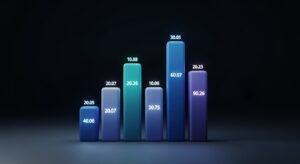Fed rate cut analysis: Interpreting the latest US jobs data and market expectations
- THE MAG POST
- Sep 7
- 6 min read

Fed rate cut analysis shapes how investors interpret a cooling labor market and a still-challenging inflation path. In contemporary policy dialogue, analysts weigh the timing and magnitude of a potential cut against a matrix of data, including job gains, wage growth, and productivity trends. This piece threads together labor data, central bank commentary, and market pricing to map plausible trajectories for policy and portfolios, emphasizing how small shifts in data can reframe risk and opportunity. The message is not about a single number but about a policy rhythm that adapts as facts change.
Labor market signals remain the most reliable compass for policy expectations in 2025. While payrolls have cooled, the path of inflation and the pace of wage growth keep policymakers cautious about the timing and scale of any easing. This analysis threads together labor data, central bank commentary, and market pricing to map plausible trajectories for policy and portfolios, emphasizing how small shifts in data can reframe risk and opportunity.
The Labor Market as a Compass for Policy
Labor market signals provide the most actionable guide for policymakers, and recent numbers underline a delicate balance between demand and supply. An August payroll gain of about 22 thousand reflects a slower pace, yet unemployment hovers around 4.3%, keeping the labor market tight and the inflation narrative unsettled. Analysts parse revisions and base effects to separate durable trends from temporary disturbances, recognizing that the next data cycle could tilt policy expectations decisively.
Interpreting the August Jobs Data
August’s job count, roughly 22,000 net additions, underscored a cooling momentum that challenges the previous robust pace. While unemployment rose modestly, the jobless rate staying near the lower end of historic ranges suggests the economy remains resilient enough to tolerance gradual tightening. The subtleties of wage growth and labor force participation matter as policymakers evaluate whether to tighten or ease policy posture.
Additionally, revisions to prior months and demographic shifts complicate the picture. Analysts stress that one month of data rarely defines the cycle; instead, they look for consistent signals across wages, hours worked, and participation, which collectively shape the odds of a rate adjustment in the near term. The outcome hinges on whether the trend persists or reverses with new information.
What the Unemployment Rate Signals
The unemployment rate around 4.3% remains a key constraint on policy, signaling a tight labor market even as growth slows. A stable rate alongside softer job gains implies moderating demand without a glaring labor shortage, potentially easing pressure on inflation expectations. Policymakers weigh whether the composition of job creation—services versus manufacturing, full-time versus part-time—alters the inflation outlook.
In this context, the Fed’s policy stance will hinge on the trajectory of wages and inflation. If wages continue to cool while inflation shows persistent but manageable upside risks, a cautious easing path could gain credibility. Conversely, a sharper uptick in inflation or a surge in payrolls could push policymakers toward a more cautious stance, delaying any anticipated cuts.
Monetary Policy Trajectory: A Small Cut, Big Implications
The próximo policy move is framed as a small adjustment with outsized effects on expectations and markets. A 25 basis points cut is widely anticipated, but the communication surrounding that move matters as much as the move itself. The balance of risks, the tone of guidance, and the inflation outlook will determine whether the cut feels accommodative or merely procedural.
Why 25 Basis Points
A 25bp reduction is often portrayed as a glide path signal—enough to ease financial conditions without reigniting demand. By threading this needle, policymakers aim to support growth and labor market stability while preserving credibility on inflation control. The magnitude matters less than the clarity of the rationale and the durability of the policy stance in the months ahead.
Market pricing has largely baked in a near-term cut, reflecting a consensus that the data justification aligns with a measured stance. Yet the exact phrasing of policymaker commentary will influence how the rate path evolves after the initial adjustment, potentially shaping expectations for subsequent meetings and risk premia across asset classes.
Potential Ripple Effects on Markets
Small policy moves tend to ripple through bond yields, stock valuations, and currency rates in ways that reflect investor risk appetite and macro uncertainty. A modest cut can lower financing costs for households and firms, potentially nudging investment and consumption higher. However, the timing and confidence of the accompanying guidance will determine whether markets view the move as preemptive or reactive to evolving data.
In practice, traders scrutinize the Fed’s dot plot, projections for inflation, and the path of the funds rate. If communications signal patience on inflation, the market may reward a gradual easing cycle; if inflation risks re-emerge, the response could be volatile, with yields whipsawing as investors reassess growth assumptions and policy durability.
Fiscal and Market Reactions: Investors Weigh the Odds
Investors balance the near-term hawkishness or dovish tilt of the center with longer-term growth and debt dynamics. Equity benchmarks react to the inflation narrative and the implied path of policy, while fixed income prices adjust to shifts in duration and credit risk. The interplay between fiscal stimuli, consumer resilience, and corporate earnings remains critical in pricing risk and opportunity.
Equity and Bond Market Responses
Equities often rally on clarity about policy direction and the prospect of cheaper capital, yet the size of any move depends on the accompanying inflation outlook. Bonds might extend gains if the cut proves durable, as yields fall and the yield curve steepens or flattens in response to revised growth expectations. The net effect hinges on the market’s assessment of credibility and risk tolerance.
Investors lean on diversification to weather shifts in policy; sector rotation typically follows the beat of inflation surprises and growth signals. Across portfolios, careful position sizing and scenario analysis help mitigate potential volatility as the market digests the central bank’s messaging and the fed funds trajectory.
Risks of Over-Correction
Even a seemingly modest move can expose portfolios to unintended consequences if inflation re-accelerates or growth falters unexpectedly. A premature withdrawal of policy accommodation could quash fragile activity, while excessive easing might reheat consumer demand and pricing power. The key is to monitor how data evolves and to adapt the asset mix accordingly, balancing duration risk and cyclicality.
Market participants should remain cautious about extrapolating one data point into a permanent trend. The risk management approach—building resilient, diversified exposures and testing multiple outcomes—encourages prudent decision-making as policy environment shifts and new indicators arrive.
Guiding Principles for Navigating a Post-Curve Landscape
When policy paths shift, investors benefit from a framework that emphasizes flexibility, risk management, and disciplined reassessment of assumptions. The post-curve landscape rewards robust scenario planning, cross-asset analysis, and transparent governance of trades. Building resilience means preparing for varied inflation and growth trajectories rather than chasing a single outcome.
Diversification and Scenario Planning
Construct portfolios that span multiple macro scenarios, including gradual easing, data-driven pauses, and potential acceleration in inflation. A balanced mix of equities, high-quality bonds, and alternatives can help dampen drawdowns and capture opportunities across regimes. Regularly stress-test holdings against a range of growth and price-level outcomes to understand vulnerabilities.
In practice, many investors adopt systematic rebalancing, risk budgets, and alert thresholds to detect regime shifts early. This disciplined approach protects capital while allowing tactical tilt adjustments as data and policy communications evolve, reducing surprise and preserving long-run objectives.
Practical Takeaways for Portfolios
Practical takeaways center on liquidity, quality, and resilience. Maintain sufficient cash or liquid assets to weather volatility, favor companies with durable cash flows, and diversify across geographies. Emphasize balance-sheet strength, flexible guidance, and earnings quality to navigate a difficult macro backdrop and a shifting policy stance.
Finally, stay attuned to data cadence and central bank commentary. The timing of a rate move is less important than the persistence of the strategy that follows: ongoing risk assessment, disciplined rebalancing, and a clear understanding of how policy will influence demand, credit, and corporate earnings over time.
Key Takeaways
What policymakers consider next
Federal policymakers weigh evidence on inflation, employment, and financial conditions, aiming for credibility in the path toward price stability while supporting growth. The decision to move or pause hinges on data, communication, and the economy’s evolving resilience, with the 25bp move acting as a signal rather than a cure-all.
What investors should do now
Investors should emphasize diversification, maintain liquidity buffers, and test multiple scenarios for inflation and growth. A disciplined approach to risk management will help navigate potential volatility as policy guidance and data unfold, aligning portfolios with longer-run objectives rather than short-term noise.
Aspect | Key Insight |
Labor data trend | Signals a cooling economy and potential policy easing, with a note: Fed rate cut analysis remains central to bets. |
Monetary stance | Markets expect a modest 25bp cut this month; policy will pivot gradually as data evolves. |
Market pricing | Implied cut probability is high, reflecting confidence in a near-term adjustment. |
Risks to the outlook | Inflation surprises or stronger growth could delay or alter the path. |
Investor takeaway | Diversification and scenario planning remain essential to weather changed policy expectations. |
Future considerations | Follow-up data and Fed commentary will reshape bets as the cycle unfolds. |


















































